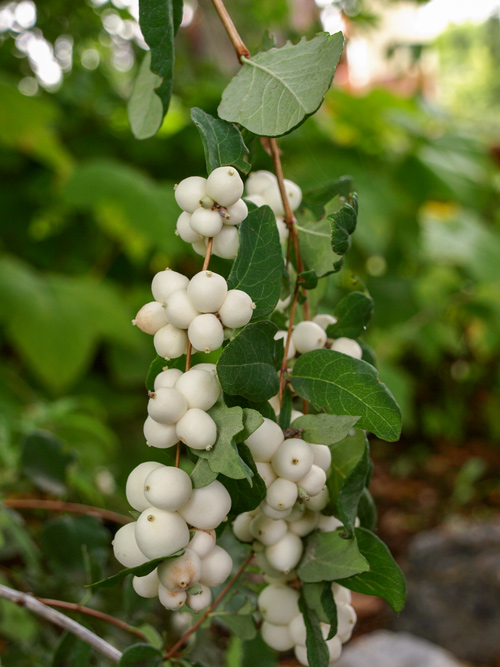Common Snowberry
Symphoricarpos albus,
(L.) Blake var. laevigatus (Fernald) Blake
© 2008 by Kristopher K. Townsend. Permission to use granted under the Creative Commons Attribution-Share Alike 4.0 International license.
Foremost in Lewis’s mind on 13 August 1805, was the need to make contact with the Shoshone Indians at the earliest possible moment, but his observational powers were in gear, nevertheless. Near Pattee Creek, Lewis wrote, he noticed “a species of honeysuckle much in it’s growth and leaf like the small honeysuckle of the Missouri only reather larger and bears a globular berry as large as a garden pea and as white as wax. this berry is formed of a thin smooth pellicle which envellopes a soft white musilagenous substance in which there are several small brown seed irregularly scattered or intermixed without any s[h]ell or perceptable membranous covering.” Within an hour or so he glimpsed, at a distance of about a mile, “two women, a man and some dogs on an eminence immediately before us.” It would be a while before he could focus on the natural landscape again.
Meanwhile, he had discovered a plant that was new to the scientific community—the snowberry. It was astute of him to recognize its membership in the honeysuckle family, Caprifoliaceae (cap-ri-fol-ee-AY-cee-ee; “a flower shaped like a hat”). Symphoricarpos is a Greek expression meaning “fruits joined together,” from the clustered pairs of berries.[1]A. Scott Earle and James L. Reveal, Lewis and Clark’s Green World: The Expedition and its Plants (Helena, Montana: Farcountry Press, 2003), 74-75. The French botanist Henri Louis Duhamel du … Continue reading That “musilagenous substance” in the berries, although not poisonous, is mealy and tasteless, and effectually unpalatable to humans, although birds, especially grouse, thrive on it. The red objects in the photo are the buds of its delicate pink trumpet-like flowers.
Lewis may have collected a specimen of the snowberry bush from the banks of Pattee Creek, but if he left it in the cache at Camp Fortunate it may have been damaged by spring floodwater the following spring. It is certain that at least a few seeds were rescued, however, for some were taken back to Philadelphia and turned over to Bernard McMahon.[2]Bernard M’Mahon (or McMahon, 1775-1816) was an Irish-born American horticulturalist and owner of a large commercial garden in Philadelphia. Under Jefferson’s instructions, the seeds … Continue reading McMahon planted them, and in October 1812 sent a few cuttings to Thomas Jefferson. Jefferson wrote to McMahon in October 1812, saying most of the cuttings were thriving in his garden, and were showing “some of the most beautiful berries I have ever seen.” In February 1813 Jefferson forwarded some cuttings from his shrubs to his friend Madame Noailles de Tessé in Paris, describing the plant as “a very handsome little shrub, of the size of a currant bush. . . . We call it the Snow-berry bush, no botanical name being yet given to it, but I do not know why we might not call it Chionicoccos, or Kallicoccos.”[3]Donald Jackson, Letters of the Lewis and Clark Expedition, with Additional Documents, 1783-1834 2nd ed., 2 vols. (Urbana: University of Illinois Press, 1978), 2:254n, 584n.
Notes
| ↑1 | A. Scott Earle and James L. Reveal, Lewis and Clark’s Green World: The Expedition and its Plants (Helena, Montana: Farcountry Press, 2003), 74-75. The French botanist Henri Louis Duhamel du Monceau (1700-1782) established the honeysuckle genus, Symphoricarpos, in 1755. |
|---|---|
| ↑2 | Bernard M’Mahon (or McMahon, 1775-1816) was an Irish-born American horticulturalist and owner of a large commercial garden in Philadelphia. Under Jefferson’s instructions, the seeds gathered by Lewis and Clark were given to M’Mahon for cultivation and ultimate distribution. His American gardeners calendar was published in 1802 |
| ↑3 | Donald Jackson, Letters of the Lewis and Clark Expedition, with Additional Documents, 1783-1834 2nd ed., 2 vols. (Urbana: University of Illinois Press, 1978), 2:254n, 584n. |
Experience the Lewis and Clark Trail
The Lewis and Clark Trail Experience—our sister site at lewisandclark.travel—connects the world to people and places on the Lewis and Clark Trail.
Discover More
- The Lewis and Clark Expedition: Day by Day by Gary E. Moulton (University of Nebraska Press, 2018). The story in prose, 14 May 1804–23 September 1806.
- The Lewis and Clark Journals: An American Epic of Discovery (abridged) by Gary E. Moulton (University of Nebraska Press, 2003). Selected journal excerpts, 14 May 1804–23 September 1806.
- The Lewis and Clark Journals. by Gary E. Moulton (University of Nebraska Press, 1983–2001). The complete story in 13 volumes.


